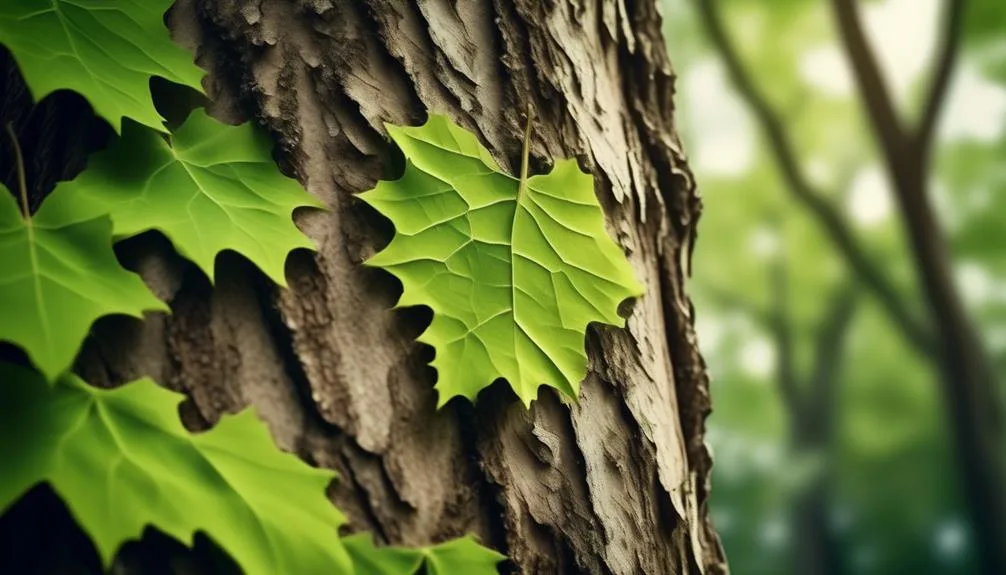Sycamore tree leaves are known for their impressive size, and there's an interesting reason behind it. These large leaves serve a purpose beyond just looking good.
But what drives sycamores to have such big leaves? In this article, we'll explore the science behind this natural phenomenon and why it's essential for the survival of these majestic trees.
Adaptation to Sunlight
Sycamore trees have developed large leaves to effectively capture sunlight for photosynthesis, allowing them to thrive in sunny environments. The size of their leaves is a remarkable adaptation to maximize sunlight exposure. With larger surface areas, sycamore leaves can absorb ample sunlight, essential for the process of photosynthesis. This adaptation is crucial for their survival in environments with high sunlight exposure, as it enables them to efficiently convert sunlight into energy.
The large leaves not only ensure that the tree receives sufficient sunlight but also contribute to the overall aesthetic appeal of the tree, creating a lush and vibrant canopy. It's fascinating how this simple yet remarkable adaptation plays a vital role in the success of sycamore trees in sunny habitats.
Efficient Photosynthesis
Adapting to sunlight through their large leaves, sycamore trees efficiently convert sunlight into energy through a process known as photosynthesis. The increased surface area of their large leaves allows them to capture more sunlight, which in turn boosts their energy production. This efficient photosynthesis enables sycamore trees to thrive in various environments, from open fields to dense forests.
Pest Protection
Sycamore trees have developed several mechanisms to protect themselves from pests, contributing to their resilience and longevity.
- Chemical Defenses: Sycamore leaves contain compounds that deter pests, making them less susceptible to insect damage.
- Leaf Size: The large size of sycamore leaves acts as a physical barrier, making it more challenging for pests to consume the entire leaf surface, thus reducing their impact on the tree.
- Indirect Defenses: Sycamore trees also attract natural predators of pests, creating a balanced ecosystem that helps control pest populations.
The combination of pest resistance and large leaf size enables sycamore trees to thrive in various environments, ensuring their continued health and vitality.
Water Conservation
To ensure the efficient use of water, sycamore trees have developed remarkable adaptations that allow them to thrive in diverse ecosystems.
Their large leaves, with a distinct leaf structure, play a crucial role in water conservation. The broad surface area of the leaves allows for efficient absorption of sunlight, vital for photosynthesis. Additionally, their size enables the sycamore tree to transpire at a higher rate, releasing water vapor from the leaves into the atmosphere. This process helps to cool the tree and maintain a balanced internal water pressure.
The transpiration rate is carefully regulated, preventing excessive water loss while still facilitating nutrient uptake from the roots. The sycamore's leaf structure and transpiration rate thus contribute to its ability to conserve water and thrive in various environmental conditions.
Species Identification
Identifying sycamore trees can be accomplished by examining their distinct leaf shape and size, bark texture, and unique seed pods.
Sycamore leaves are large, reaching up to 10 inches in width, and have a unique shape with three to five lobes.
The bark of mature sycamore trees is characterized by its mottled appearance, with patches of white, tan, and brown.
Additionally, sycamore trees produce distinctive spherical seed pods that hang in clusters from the branches.
When identifying sycamore trees, it's important to consider environmental factors that can affect leaf size, such as sunlight and water availability.
Keep in mind that leaf size may vary based on the specific conditions in which the tree is growing.
Conclusion
In awe of sycamore trees and their remarkable adaptations, let's appreciate how their large leaves serve multiple essential purposes in the natural world.
These striking features not only maximize photosynthesis and protect against pests but also help conserve water and aid in species identification.
Their existence reminds us of nature's incredible efficiency and the interconnectedness of all living things.

My interest in trees started when I first saw the giant sequoias in Yosemite.
I was a teenager then, and I remember thinking, “I need to learn more about this.”
That moment stuck with me.
A few years later, I went on to study forestry at Michigan Tech.
Since graduating, I’ve worked in a mix of hands-on tree care and community education.
I’ve spent over ten years helping people understand how to plant, maintain, and protect the trees in their neighborhoods.
I don’t see trees as just part of the landscape.
They are living things that make a real difference in our daily lives.
